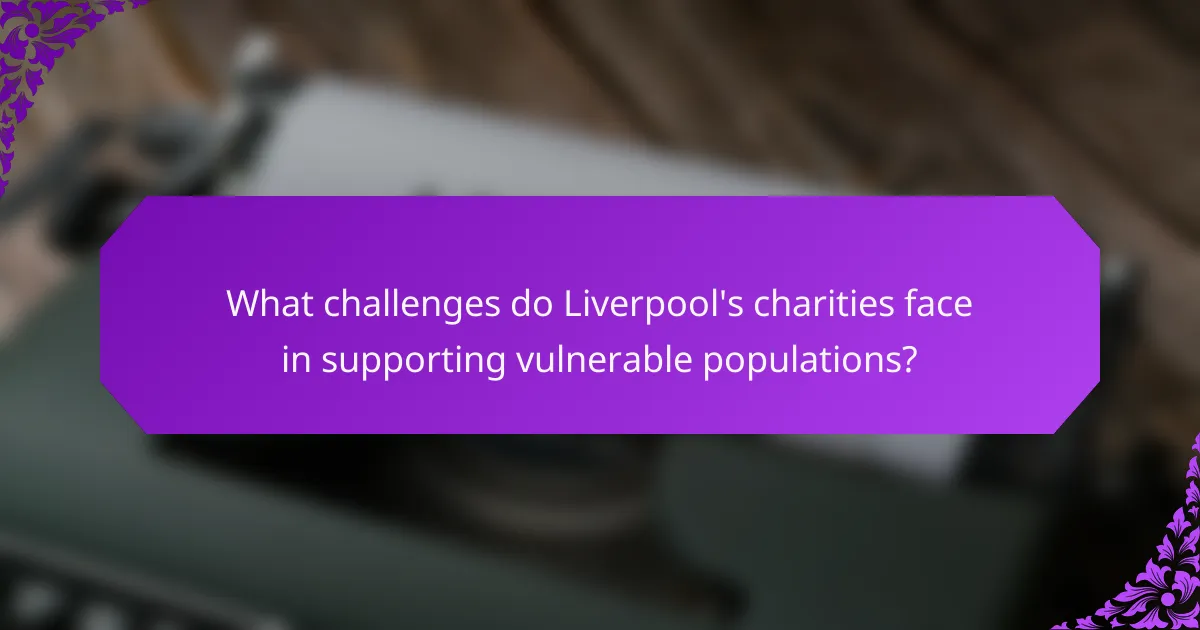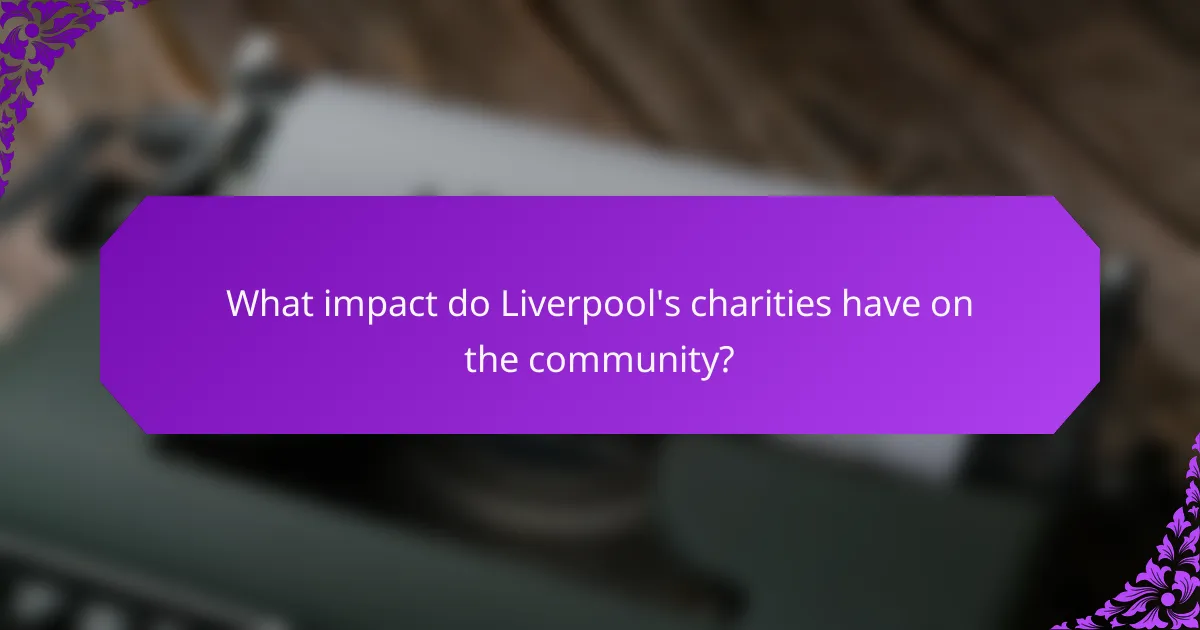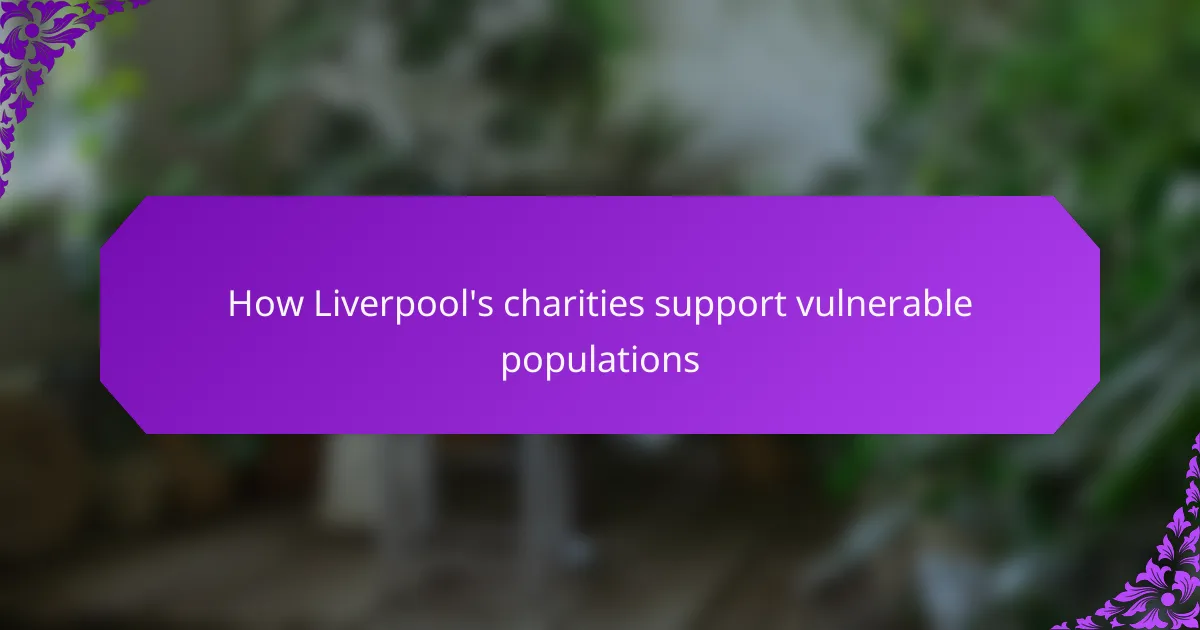Liverpool’s charities play a vital role in supporting vulnerable populations through targeted programs and services. They address immediate needs by providing food banks, mental health support, housing assistance, and educational programs aimed at improving skills and employability. Despite facing challenges such as limited funding, increased demand for services, and staffing shortages, these organizations contribute significantly to the local economy and community welfare. Their collaborative efforts enhance social cohesion and empower individuals, ultimately reducing poverty and improving overall well-being in the region.

How do Liverpool’s charities address the needs of vulnerable populations?
Liverpool’s charities address the needs of vulnerable populations through various targeted programs and services. They provide food banks to combat hunger among low-income families. Many offer mental health support for individuals facing emotional challenges. Charities also supply housing assistance to help the homeless transition into stable living conditions. Educational programs are available to improve skills and employability for disadvantaged groups. Additionally, charities conduct outreach initiatives to connect vulnerable individuals with necessary resources. They collaborate with local organizations to enhance community support systems. Statistics show that these efforts significantly reduce poverty and improve overall well-being in the region.
What types of vulnerable populations do Liverpool’s charities support?
Liverpool’s charities support various vulnerable populations. These include the homeless, individuals with mental health issues, and refugees. They also assist low-income families and children in need. Additionally, charities provide support for the elderly and those with disabilities. Many organizations focus on victims of domestic abuse. Statistics indicate that charities in Liverpool play a crucial role in addressing these needs. For example, local shelters report serving hundreds of homeless individuals each year. This support helps improve the quality of life for these vulnerable groups.
How do charities identify the specific needs of these populations?
Charities identify the specific needs of vulnerable populations through various methods. They conduct needs assessments, which involve surveys and interviews with community members. This direct engagement helps charities understand individual circumstances and challenges. Data analysis is also utilized to identify trends and areas of concern within populations. Collaborating with local organizations enhances their understanding of community dynamics. Regular feedback from beneficiaries informs program adjustments and improvements. Additionally, charities may use statistical data from government reports to guide their initiatives. These combined approaches ensure that charities effectively address the unique needs of the populations they serve.
What demographic factors influence the support provided?
Demographic factors that influence the support provided include age, gender, income level, and ethnicity. These factors affect the types of services needed and the accessibility of support. For instance, younger populations may require different support services compared to older adults. Gender can influence the specific challenges faced and the types of support that are sought. Income level often determines the availability of resources and access to services. Ethnicity may impact cultural perceptions of support and the willingness to seek help. Research indicates that these demographic factors shape how services are designed and delivered in communities, ensuring that support is tailored to meet diverse needs.
What are the primary services offered by Liverpool’s charities?
Liverpool’s charities primarily offer services such as food distribution, housing support, and mental health assistance. They provide emergency food supplies to individuals and families in need. Many organizations focus on homelessness prevention and provide temporary accommodation. Mental health services include counseling and support groups. Additionally, charities offer educational programs aimed at skill development. They also provide healthcare services, including access to medical professionals. These services aim to support vulnerable populations effectively. According to the Liverpool Charity and Voluntary Sector Report, these initiatives reach thousands annually.
How do these services vary among different charities?
Charity services vary significantly based on their mission and target populations. Some charities focus on providing food and shelter, while others emphasize mental health support or educational programs. For example, food banks offer immediate relief through meal distribution. In contrast, organizations like homeless shelters provide long-term housing solutions. Additionally, charities may differ in their approach to fundraising and community engagement. Some utilize volunteers extensively, while others rely on paid staff for service delivery. This diversity allows charities to address specific needs within vulnerable populations effectively. Research shows that targeted services lead to better outcomes for those in need.
What role do volunteers play in delivering these services?
Volunteers are essential in delivering services through Liverpool’s charities. They provide manpower for various programs and initiatives. Volunteers assist in distributing food, offering companionship, and providing support to vulnerable populations. Their involvement enhances the capacity of charities to reach more individuals in need. For instance, volunteers often help organize events and fundraisers, increasing community engagement. According to the National Council for Voluntary Organisations, 75% of charities rely on volunteers to fulfill their missions. This statistic highlights the significant impact volunteers have on service delivery.
How do Liverpool’s charities collaborate with local organizations?
Liverpool’s charities collaborate with local organizations through various partnerships and joint initiatives. These collaborations often focus on addressing community needs such as poverty, health, and education. Charities leverage local knowledge and resources to enhance their impact. They may co-host events, share funding opportunities, or develop joint programs. For example, charities might work with schools to provide after-school programs. They also engage with local businesses for sponsorships and support. This collaborative approach ensures a more comprehensive response to issues faced by vulnerable populations. By pooling resources and expertise, charities can reach more individuals in need effectively.
What partnerships enhance the effectiveness of charitable efforts?
Collaborations with local businesses, government agencies, and other non-profits enhance the effectiveness of charitable efforts. Local businesses can provide funding, resources, or in-kind donations, which significantly boost operational capabilities. Government agencies often offer grants and support services that align with charitable missions. Partnerships with other non-profits allow for resource sharing and combined outreach efforts. For example, joint events can increase visibility and engagement within the community. Research shows that collaborative approaches lead to a 25% increase in resource allocation for charities. This evidence supports the notion that strategic partnerships are vital for maximizing impact in charitable initiatives.
How does collaboration improve resource allocation?
Collaboration improves resource allocation by enhancing efficiency and reducing redundancy. When organizations work together, they can share information and resources. This leads to a more strategic distribution of funds and services. For instance, charities in Liverpool often combine efforts to target specific community needs. By pooling resources, they can maximize their impact. Research shows that collaborative initiatives can lead to a 30% increase in resource utilization. This demonstrates the effectiveness of teamwork in addressing vulnerable populations’ needs.

What challenges do Liverpool’s charities face in supporting vulnerable populations?
Liverpool’s charities face several challenges in supporting vulnerable populations. Limited funding is a significant issue, impacting their ability to provide essential services. Many charities rely on donations, which can fluctuate. Increased demand for services due to economic downturns adds pressure. Charities also struggle with resource allocation, often needing to prioritize urgent cases. Staffing shortages can hinder service delivery and outreach efforts. Additionally, navigating complex regulations can complicate their operations. Collaboration among charities is often necessary but can be difficult to coordinate. These challenges collectively affect the effectiveness of support provided to vulnerable communities in Liverpool.
How do funding issues impact the operations of these charities?
Funding issues severely limit the operations of charities. Insufficient funds can lead to reduced services and programs. Charities may struggle to hire and retain qualified staff. This can diminish the quality of support provided to vulnerable populations. Additionally, funding shortfalls often result in delayed or canceled initiatives. Charities may also face challenges in maintaining facilities and resources. For example, a 2020 report indicated that 60% of charities in Liverpool reported funding challenges affecting their operations. Such financial constraints can ultimately hinder their mission to support those in need.
What strategies are employed to overcome financial obstacles?
Charities in Liverpool employ various strategies to overcome financial obstacles faced by vulnerable populations. They offer financial literacy programs to educate individuals on budgeting and saving. These programs help participants manage their finances more effectively. Charities also provide emergency financial assistance to address immediate needs. This support can include food vouchers, utility bill payments, and housing assistance. Additionally, many charities partner with local businesses to create job training programs. These initiatives enhance employability and provide pathways to stable income. Fundraising events and grant applications are also crucial for securing necessary resources. These strategies collectively enable charities to support vulnerable populations effectively.
How do charities manage resource scarcity?
Charities manage resource scarcity by prioritizing needs and maximizing efficiency. They assess community demands to identify critical areas for support. Charities often collaborate with other organizations to pool resources. This collaboration can lead to shared services and reduced operational costs. They also utilize volunteer labor to expand their capacity without increasing expenses. Fundraising campaigns are strategically designed to target specific needs. Charities may apply for grants to secure additional funding. Data-driven decision-making allows them to allocate resources effectively. This approach has been shown to improve service delivery and sustainability.
What social barriers affect the outreach of Liverpool’s charities?
Social barriers affecting the outreach of Liverpool’s charities include poverty, lack of awareness, and social stigma. Poverty limits individuals’ access to resources and information about available services. Many residents may not know about the charities due to insufficient marketing or outreach efforts. Social stigma surrounding certain issues, such as homelessness or mental health, can deter people from seeking help. Additionally, language barriers can hinder communication with diverse communities. These factors collectively reduce the effectiveness of charitable outreach in Liverpool.
How do stigmas surrounding vulnerability hinder access to support?
Stigmas surrounding vulnerability significantly hinder access to support by creating barriers to seeking help. Individuals may fear judgment or rejection when disclosing their vulnerabilities. This fear can lead to isolation, preventing them from reaching out to available resources. Research shows that stigma can deter people from accessing mental health services, with 40% of individuals reporting concerns about being labeled as weak. Additionally, stigmas can perpetuate feelings of shame, making it difficult for vulnerable individuals to advocate for their needs. Consequently, this results in underutilization of support services designed to assist them.
What measures are taken to raise awareness and reduce stigma?
Charities in Liverpool implement various measures to raise awareness and reduce stigma. They conduct educational campaigns to inform the public about issues affecting vulnerable populations. These campaigns often include workshops, seminars, and community events. Charities collaborate with local media to share stories and promote understanding. They utilize social media platforms to reach a wider audience. Many organizations provide training for volunteers and staff on sensitivity and inclusivity. Support groups are established to foster dialogue among affected individuals. Research indicates that awareness initiatives can significantly improve public perception and acceptance. Studies show that increased knowledge leads to reduced stigma and greater community support.

What impact do Liverpool’s charities have on the community?
Liverpool’s charities significantly enhance community welfare. They provide essential services such as food banks, mental health support, and educational programs. These organizations address immediate needs and promote long-term empowerment. For instance, local charities like The Whitechapel Centre help the homeless with shelter and job training. According to the Liverpool City Region Combined Authority, charities contribute over £1 billion annually to the local economy. This financial input creates jobs and stimulates local businesses. Additionally, community engagement initiatives foster social cohesion and volunteerism. Overall, Liverpool’s charities play a crucial role in supporting vulnerable populations and improving community resilience.
How do these charities measure their effectiveness?
Charities measure their effectiveness through various methods. They often use metrics such as the number of individuals served and outcomes achieved. Surveys and feedback from beneficiaries provide insights into program impact. Data analysis helps assess the efficiency of resource allocation. Many charities also track financial sustainability and fundraising success. Regular reporting and evaluation ensure accountability to stakeholders. Collaborations with external evaluators can provide objective assessments. These methods help charities refine their strategies and improve services for vulnerable populations.
What metrics are used to assess the success of their programs?
Metrics used to assess the success of programs include participant feedback, program reach, and outcome measurements. Participant feedback gauges satisfaction and perceived effectiveness. Program reach measures the number of individuals served. Outcome measurements evaluate specific changes in beneficiaries’ circumstances. These metrics provide a comprehensive view of program effectiveness. Data collected from these metrics informs future program adjustments. Regular assessments ensure that charities meet their goals.
How do success stories contribute to community engagement?
Success stories enhance community engagement by showcasing positive outcomes and inspiring participation. They provide relatable examples of how initiatives have made a difference. This relatability fosters a sense of connection among community members. When individuals see real-life impacts, they are more likely to get involved. Success stories also build trust in organizations and their missions. This trust encourages donations and volunteerism. Research indicates that storytelling can increase community involvement by up to 30%. Engaging narratives create a shared vision and motivate collective action.
What best practices can be adopted to enhance charity efforts?
To enhance charity efforts, organizations should prioritize transparency and accountability. This builds trust with donors and beneficiaries. Regularly sharing financial reports and outcomes increases credibility. Engaging the community fosters collaboration and support. Utilizing social media for outreach expands awareness and donor engagement. Establishing partnerships with local businesses can amplify resources and reach. Training volunteers effectively ensures they are equipped to assist. Setting measurable goals allows for tracking progress and impact. These practices are supported by studies showing increased donor retention and community involvement when charities operate transparently.
How can charities improve volunteer recruitment and retention?
Charities can improve volunteer recruitment and retention by implementing targeted outreach strategies. They should clearly communicate their mission and impact to attract like-minded individuals. Offering flexible volunteering options can cater to diverse schedules and availability. Providing training and support helps volunteers feel valued and competent in their roles. Regular recognition of volunteer contributions fosters a sense of belonging and commitment. Creating a community among volunteers encourages networking and shared experiences. According to a study by the National Council for Voluntary Organisations, 70% of volunteers are motivated by a desire to make a difference. This highlights the importance of aligning volunteer opportunities with personal values to enhance recruitment and retention.
What innovative approaches can be implemented to reach more individuals in need?
Utilizing technology to enhance outreach can effectively reach more individuals in need. Charities can implement mobile apps to facilitate communication and access to services. These apps can provide real-time information on available resources. Social media campaigns can raise awareness and engage the community. Virtual support groups can offer assistance to those unable to attend in person. Data analytics can help identify underserved areas and target outreach efforts. Partnerships with local businesses can expand resource availability and visibility. Community events can foster connections and promote available services. These innovative approaches can significantly improve access for vulnerable populations in Liverpool.
Liverpool’s charities play a crucial role in supporting vulnerable populations by providing essential services such as food distribution, mental health assistance, housing support, and educational programs. They address the needs of various demographics, including the homeless, low-income families, individuals with mental health challenges, and refugees. Charities employ strategies to identify specific needs through community engagement and data analysis, while also facing challenges like funding limitations and social stigmas that hinder outreach. Collaboration with local organizations and innovative approaches are vital for enhancing resource allocation and effectively reaching those in need. The impact of these charities is significant, contributing to community welfare and resilience in Liverpool.
